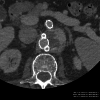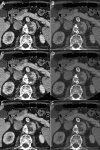Enhanced visualization in endoleak detection through iterative and AI-noise optimized spectral reconstructions
- PMID: 38360941
- PMCID: PMC10869818
- DOI: 10.1038/s41598-024-54502-1
Enhanced visualization in endoleak detection through iterative and AI-noise optimized spectral reconstructions
Abstract
To assess the image quality parameters of dual-energy computed tomography angiography (DECTA) 40-, and 60 keV virtual monoenergetic images (VMIs) combined with deep learning-based image reconstruction model (DLM) and iterative reconstructions (IR). CT scans of 28 post EVAR patients were enrolled. The 60 s delayed phase of DECTA was evaluated. Objective [noise, contrast-to-noise ratio (CNR), signal-to-noise ratio (SNR)] and subjective (overall image quality and endoleak conspicuity - 3 blinded readers assessment) image quality analyses were performed. The following reconstructions were evaluated: VMI 40, 60 keV VMI; IR VMI 40, 60 keV; DLM VMI 40, 60 keV. The noise level of the DLM VMI images was approximately 50% lower than that of VMI reconstruction. The highest CNR and SNR values were measured in VMI DLM images. The mean CNR in endoleak in 40 keV was accounted for as 1.83 ± 1.2; 2.07 ± 2.02; 3.6 ± 3.26 in VMI, VMI IR, and VMI DLM, respectively. The DLM algorithm significantly reduced noise and increased lesion conspicuity, resulting in higher objective and subjective image quality compared to other reconstruction techniques. The application of DLM algorithms to low-energy VMIs significantly enhances the diagnostic value of DECTA in evaluating endoleaks. DLM reconstructions surpass traditional VMIs and IR in terms of image quality.
Keywords: Abdominal aortic aneurysms; Adaptive statistical iterative reconstruction; Dual-energy computed tomography angiography; Endoleak; Endovascular aneurysm repair; Image reconstruction, deep learning model; Virtual monoenergetic images.
© 2024. The Author(s).
Conflict of interest statement
The authors declare no competing interests.
Figures






Similar articles
-
Value of a noise-optimized virtual monoenergetic reconstruction technique in dual-energy CT for planning of transcatheter aortic valve replacement.Eur Radiol. 2017 Feb;27(2):705-714. doi: 10.1007/s00330-016-4422-3. Epub 2016 May 28. Eur Radiol. 2017. PMID: 27236818
-
Deep learning-based image reconstruction of 40-keV virtual monoenergetic images of dual-energy CT for the assessment of hypoenhancing hepatic metastasis.Eur Radiol. 2022 Sep;32(9):6407-6417. doi: 10.1007/s00330-022-08728-0. Epub 2022 Apr 5. Eur Radiol. 2022. PMID: 35380228
-
Endoleaks after endovascular aortic aneurysm repair: Improved detection with noise-optimized virtual monoenergetic dual-energy CT.Eur J Radiol. 2017 Sep;94:125-132. doi: 10.1016/j.ejrad.2017.06.017. Epub 2017 Jun 27. Eur J Radiol. 2017. PMID: 28712695
-
Deep learning image reconstruction for low-kiloelectron volt virtual monoenergetic images in abdominal dual-energy CT: medium strength provides higher lesion conspicuity.Acta Radiol. 2024 Sep;65(9):1133-1146. doi: 10.1177/02841851241262765. Epub 2024 Jul 21. Acta Radiol. 2024. PMID: 39033390
-
[Effect of a noise-optimized virtual monoenergetic reconstruction technique on dual-energy CT for image quality of inflammatory bowel disease].Zhong Nan Da Xue Xue Bao Yi Xue Ban. 2018 Aug 28;43(8):875-881. doi: 10.11817/j.issn.1672-7347.2018.08.009. Zhong Nan Da Xue Xue Bao Yi Xue Ban. 2018. PMID: 30197316 Chinese.
Cited by
-
Noise-Optimized CBCT Imaging of Temporomandibular Joints-The Impact of AI on Image Quality.J Clin Med. 2024 Mar 5;13(5):1502. doi: 10.3390/jcm13051502. J Clin Med. 2024. PMID: 38592413 Free PMC article.
-
The Impact of AI on Metal Artifacts in CBCT Oral Cavity Imaging.Diagnostics (Basel). 2024 Jun 17;14(12):1280. doi: 10.3390/diagnostics14121280. Diagnostics (Basel). 2024. PMID: 38928694 Free PMC article.
-
AI-Driven Advances in Low-Dose Imaging and Enhancement-A Review.Diagnostics (Basel). 2025 Mar 11;15(6):689. doi: 10.3390/diagnostics15060689. Diagnostics (Basel). 2025. PMID: 40150031 Free PMC article. Review.
-
Dual-Energy and Photon-Counting Computed Tomography in Vascular Applications-Technical Background and Post-Processing Techniques.Diagnostics (Basel). 2024 Jun 11;14(12):1223. doi: 10.3390/diagnostics14121223. Diagnostics (Basel). 2024. PMID: 38928639 Free PMC article. Review.
-
Assessing the diagnostic accuracy of artificial intelligence in post-endovascular aneurysm repair endoleak detection using dual-energy computed tomography angiography.Pol J Radiol. 2024 Aug 28;89:e420-e427. doi: 10.5114/pjr/192115. eCollection 2024. Pol J Radiol. 2024. PMID: 39257927 Free PMC article.
References
MeSH terms
LinkOut - more resources
Full Text Sources

